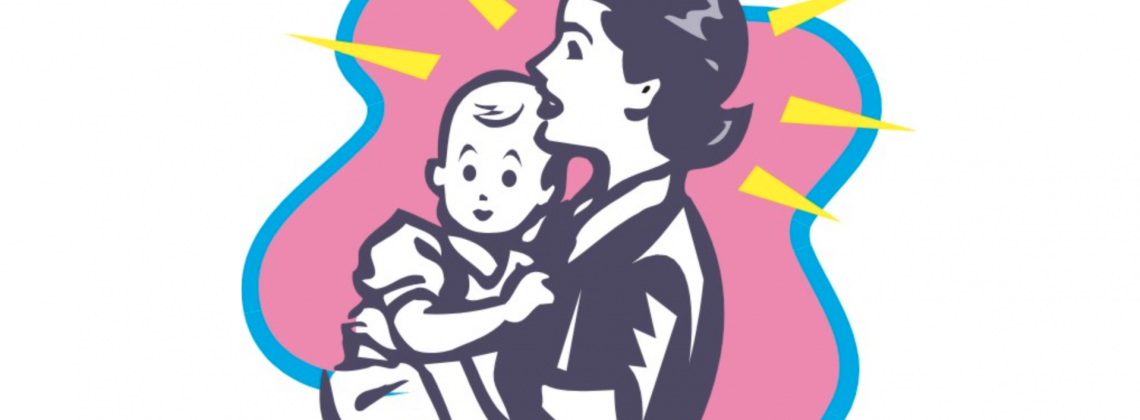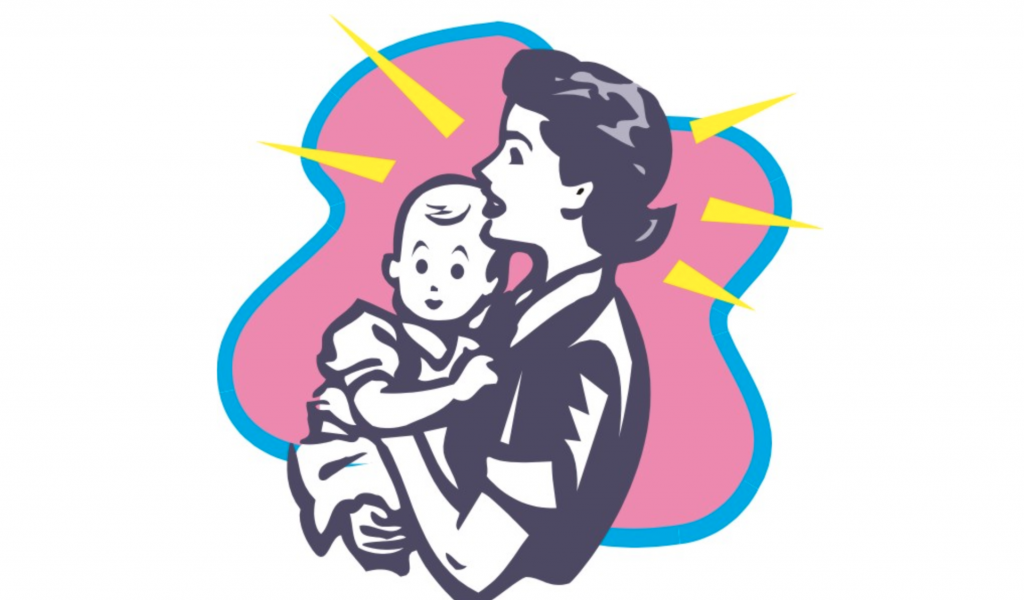

If you can’t “have it all,” what can you have?
Screaming on the Inside: The Unsustainability of American Motherhood by Jessica Grose. Mariner Books, 2022. 240 pp., $28.99
A poet friend once sent an online query asking for metaphors about motherhood. The responses she got favored sunrise, baskets, and farming. Jessica Grose picks less gauzy images to visualize the experience in Screaming on the Inside: The Unsustainability of American Motherhood, the cover of which features moms falling asleep on computer keyboards, buckling car seats, scrubbing floors at the foot of a high chair (whose occupant kicks the mom in the head), and hunching over the toilet with morning sickness.
Grose, opinion writer at the New York Times and editor of its parenting newsletter, makes two main arguments: that being a mother is hard, and that America makes it harder. Hardship of the first kind came right away for her, through the physical toll of pregnancy, birth, and nursing. The second kind cascaded thereafter: medical management of maternity doing too much or too little; tricky-to-find childcare; workplaces heedless of family needs. She studies the familiar problems that became acute during Covid-19, when women’s lives as mothers and workers, already stretched thin, got worse.
Much about her reporting rings true. Grose finds motherhood now “uniquely difficult in the amount of information we get about what we’re supposed to be doing, and how high the stakes are made to seem about every minor decision.” I should note that I discussed this with Grose in a conversation about maternity in American history. Still, the book makes uneven use of the past to make its case. Learning about motherhood across a few centuries, a casual reader could come away with the conclusion that America always dumped on moms. It is clearly easier to be a middle-class mom now than, say, on a frontier homestead with no power, plumbing, pediatrician, or polio vaccine. Yet it is not the case that being an American mom has always been hard and still is today. Rather, it has become hard in different ways. The burdens specific to motherhood now result substantially from changed realities of work and changed expectations about childrearing.
Grose’s plaints are not primarily about work itself, although she does confront sexism and awkwardness there, and she interviews women whose jobs are much worse than average. The problem is the absence of systems designed to help care for children and the default assignment of family burdens to women. Significantly, Grose’s lament is specific to mothers and not “parents,” generic and ungendered.
In some respects, Grose’s book reads as an entry into long-running disputes about what used to be called “having it all.” Having it all meant women arranging life so that they could exercise their gifts and be paid for doing so, and also could get married and have children. The argument flared in the 1980s and 90s and again earlier this century, when Facebook’s Sheryl Sandberg advised women to “lean in” to challenging careers without fearing family dilemmas. American women may not read Sandberg’s book, but they follow her maxims. Grose’s audience came to adulthood having been advised that women need not limit themselves too early in their careers by worrying about how they will manage kids, because when the time comes, there will be childcare. As things turned out, there wasn’t childcare.
Instead, today’s norm presupposes that “mothers should earn money but also stay home with young children.” This, Grose contends, is “the worst of all possible worlds.” Her exasperation is warranted, but we should hardly wonder that systems built predominantly by and for male workers did not come complete with nurseries. The system could use retrofitting. Grose requests the tools often advised for such a remodel: from the state, family subsidies and parental leave and relevant regulation, and from employers, paid leave and promotion routes that don’t penalize moms.
In the pandemic’s wake, those prescriptions hardly sound radical. Grose diagnoses problems and prescribes solutions. So why the scream? Because ideals of motherhood make run-ragged moms feel like they are never doing enough.
Grose cringes at the American ideal of mom, usually a cheerful blonde with a clean house, fresh cookies, clever crafts, and perfect children who pose sweetly for pictures as the manicured mama quips, “Life is so fun with them.” This mom puts “maximal effort” into sweet things for her kids. She installs “that gleaming kitchen backsplash herself” and makes a TikTok to show you how to do it. Grose is not making up this cartoon character. This is social media’s model mother, puffed larger than life online. If this is what counts as a good mom, most will never measure up, particularly if they also hold jobs. Real moms are shamed by this archetype who effortlessly does so much.
And there is so much extra to do. Motherhood changed because fashions of childrearing changed. Grose faults current conventions of motherhood but does not fault enough the childhood culture that also bears blame. What theorists call intensive parenting aims at kids’ high-earning futures while festooning youth with bells, whistles, and tournaments conspicuously absent from earlier generations’ upbringings. Consumer culture stokes little ones’ wants. Social expectation nudges moms to deliver. Unflattering comparisons between America’s family policies and Europe’s are de rigueur in a book like this, but it’s strange to see the claim that European moms have it easier because they basically want their kids to be happy, to “feel safe and loved.” Imagine, Grose wonders, “If the bar for ‘good mother’ was that your children felt safe and loved, it would be a much less stressful and soul-crushing proposition than our current American standards.” That’s probably not so. Making somebody else feel safe and loved is a tall order.
Still, why is the scream on the inside? I fault the having-it-all formulation. The phrase always rang false by implying that satisfying work was something you “have,” as was a loving family, rather than things you “did” or “had to” have or do. Implications of that error are profound for both work and family life. When leaning in to have it all, satisfying work gets put first. A family is what you choose second and only if you want it. You can choose to have kids if you want them, because it will be fun.
Family life can enrich in terms that soar high above fun, but much about childrearing also falls far below. The expectation that women chirp “Life is so fun” amid the daily doings generates inadequacy and frustration.
Grose avoids pitting stay-at-home moms against employed ones. Her unflattering contrasts come between those “just trying to do their best” and those whose too-perfect life is sponsored content. She tells American women to disregard motherhood ideals, and “expand the vision of what a ‘good’ mother is.” A closing chapter profiles women who supplement their jobs and parenting with social justice advocacy. Though that’s a better reason than others for moms to be stretched so thin, these examples substitute one unsustainable motherhood ideal for another.
Grose’s ideal delivers a species of having it all—with help. But is the problem that women need help with all they have going, or that we need to stop pursuing the competitive, consumption-driven model that many families now take for granted? More sensibly, we can describe work and family life as what we do, not have, mindful that goods can conflict. And because much already needs doing, we might excise the things that really aren’t essential, like the posing and posting and maybe even the backsplash.
Agnes R. Howard teaches in Christ College, the honors college at Valparaiso University, and is author of Showing: What Pregnancy Tells Us about Being Human.